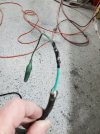Dean Jenkins
Promoted Users
I've seen @Barry and a few others mention grounding the vehicle, in various posts, as one of the steps in controlling dust while painting.
Thought I would give it a try, and it made a big difference. Wow!
It makes sense as air flowing over a panel can generate static electricity, which then attracts any dust in the air.
Grounding the vehicle eliminates the static.
But, to work, it has to be a "true ground."
I've seen some folks, on other groups, say they loop a chain over the axle and let it sit on the floor, to ground the vehicle.
Not to be mean, but that is somewhat comical. The axle housing in nearly every situation (when you are painting the body) is going to have some type of coating, paint or powdercoat, etc. so it will not conduct electricity. And most shop floors are concrete, which is more of an insulator to electricity than a conductor.
For this to work, a connection to a real ground needs to be made to bare metal on the car.
If the electrical system in your shop was done to code, then you've got a perfect ground in every outlet in the shop.
Here is what I did:
Took an old extension cord (it must be a 3-prong, with a ground wire), cut back the outer sheathing, cut the white and black wires back about 1 1/2".

I taped both ends of the black and white wires with electrical tape, and then taped the whole thing up. No way this can shock anyone.

I then attached an alligator clip, on the other end, to the green ground wire.

Then it is just a matter of finding a suitable place on the car to connect the alligator clip to.
It must be bare metal, and that bare metal must have a conductive connection to the frame or body.
A screw or bolt, that is not coated, and the threads go through the frame or sheet metal, is ideal.
I connected it to a screw on the frame that was for a brake line clamp. I also went the extra step to make sure frame and body were electrically connected. Since the body mounts on rubber spacers, and everything was epoxied before I assembled it, I wasn't sure that there was continuity between the body and frame, but there was, probably from the bolts holding the inner fenders to the frame. And of course all the body panels are bolted together, so they have continuity.
Then I plugged the cord into the outlet. Car grounded!
And as I said at the start, it made a huge difference. Least amount of trash I've ever had, in fact as far as I could see with a quick look last night, it was zero.
Hope that helps someone.
Thought I would give it a try, and it made a big difference. Wow!
It makes sense as air flowing over a panel can generate static electricity, which then attracts any dust in the air.
Grounding the vehicle eliminates the static.
But, to work, it has to be a "true ground."
I've seen some folks, on other groups, say they loop a chain over the axle and let it sit on the floor, to ground the vehicle.
Not to be mean, but that is somewhat comical. The axle housing in nearly every situation (when you are painting the body) is going to have some type of coating, paint or powdercoat, etc. so it will not conduct electricity. And most shop floors are concrete, which is more of an insulator to electricity than a conductor.
For this to work, a connection to a real ground needs to be made to bare metal on the car.
If the electrical system in your shop was done to code, then you've got a perfect ground in every outlet in the shop.
Here is what I did:
Took an old extension cord (it must be a 3-prong, with a ground wire), cut back the outer sheathing, cut the white and black wires back about 1 1/2".
I taped both ends of the black and white wires with electrical tape, and then taped the whole thing up. No way this can shock anyone.
I then attached an alligator clip, on the other end, to the green ground wire.
Then it is just a matter of finding a suitable place on the car to connect the alligator clip to.
It must be bare metal, and that bare metal must have a conductive connection to the frame or body.
A screw or bolt, that is not coated, and the threads go through the frame or sheet metal, is ideal.
I connected it to a screw on the frame that was for a brake line clamp. I also went the extra step to make sure frame and body were electrically connected. Since the body mounts on rubber spacers, and everything was epoxied before I assembled it, I wasn't sure that there was continuity between the body and frame, but there was, probably from the bolts holding the inner fenders to the frame. And of course all the body panels are bolted together, so they have continuity.
Then I plugged the cord into the outlet. Car grounded!
And as I said at the start, it made a huge difference. Least amount of trash I've ever had, in fact as far as I could see with a quick look last night, it was zero.
Hope that helps someone.



